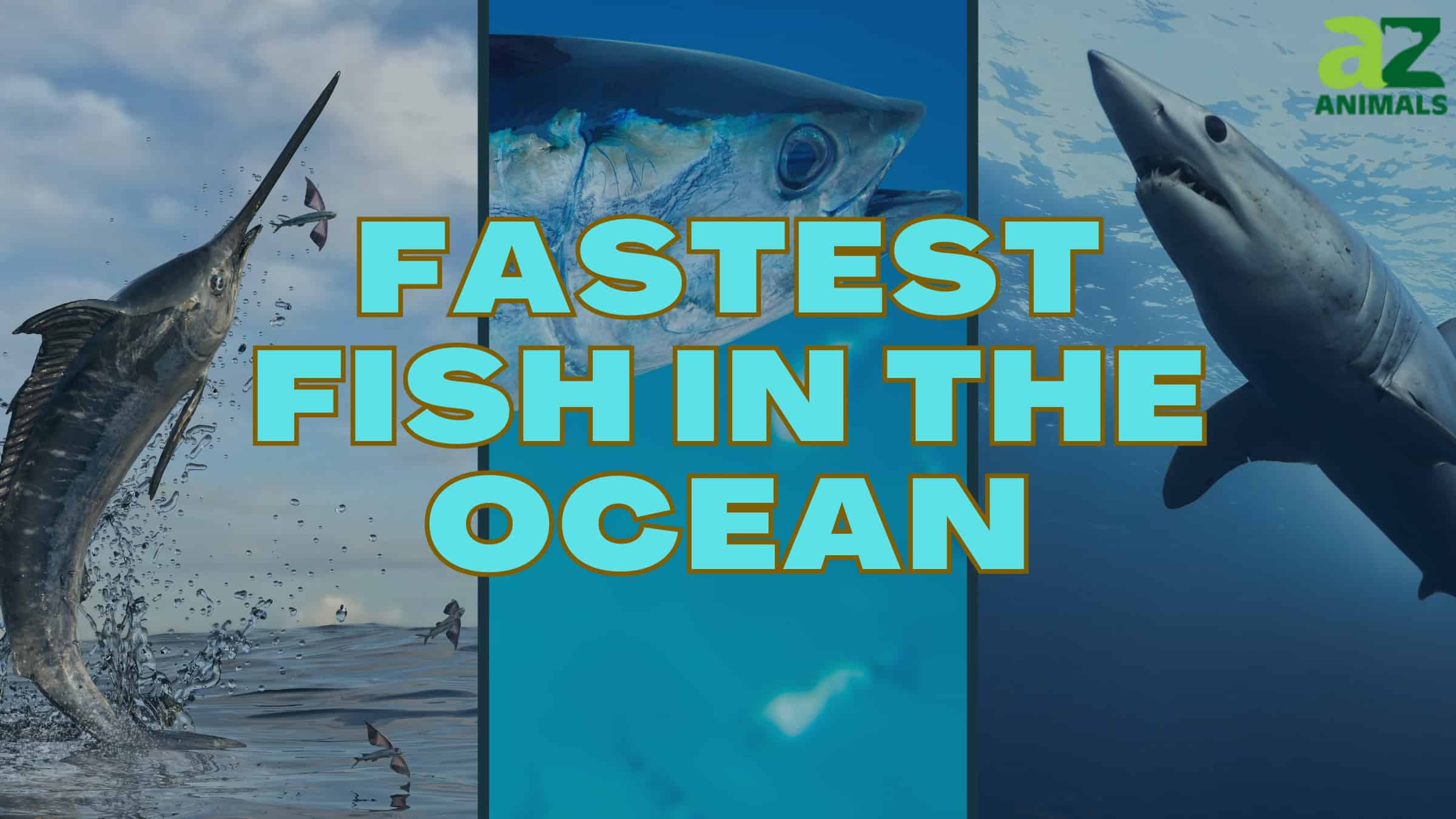The animal kingdom is full of useful survival strategies, from poison to thick skin. But no matter the medium in which they move, including land, air, and even water, speed seems to be a universal and important asset to have evolved.
If you cannot surprise, outlast, or outwit your predator or prey, then it’s very useful to outrun or outswim them. It’s nevertheless remarkable that some fish species can achieve high speeds in the water, given the amount of resistance and drag they have to deal with. Have you ever wondered — what is the fastest fish in the ocean?
The keys to the fish’s speed are the streamlined shape, the powerful muscles, and the numerous fins arrayed around the body, including (but not limited to) the dorsal fins projecting from the back, the pectoral fins on the sides, the anal fin, and the tail fin (which is responsible for most of the forward propulsion). Composed of bony spines or rays, these fins provide the fish with superb speed, stability, and maneuverability.
All fish (as well as sharks) share these basic traits in common. However, the fastest fish in the ocean all have an extra adaptation designed to lower drag and improve their ability to cut through the water. Most of the fish on this list have large dorsal fins and sharp snouts. While all fish use speed and agility to their advantage, certain species stand above the rest in terms of their relentless speed.
This list documents the top 10 fastest fish in the ocean known in the world. Keep in mind that some measurements may be necessarily imprecise. Fish speeds are hard to measure in the water, and many figures may be based on single non-replicable reports. This article takes into account some of that uncertainty. Here are the 10 fastest fish in the ocean.

#1 Sailfish
Unmistakable due to the gigantic sail on its back, the sailfish is considered to be the fastest fish in the ocean. Some reports indicate it is capable of speeds nearly 70 miles per hour while leaping out of the water, although the actual swimming speed is probably much slower. As a member of the marlin family, there are two recognized species in the sailfish genus: the Atlantic sailfish and the Indo-Pacific sailfish.
There are many interesting aspects to the fish’s physiology. First off, these are large fish, measuring up to 10 feet long and 200 pounds. Second, and despite popular misconception, their sword-like bills are not used to spear prey. Instead, the bills allow them to stun larger prey such as crustaceans and squids, often when they’re working together in groups of two or more. But the huge dorsal fin, which reaches at least a foot high, is the most conspicuous feature of this fish. Like an actual boat sail, it can be folded against the body when it isn’t needed. But when the fish attacks its prey, the sail will suddenly be raised, as if on high alert, so it can maneuver better through the water.

Many scientists consider the sailfish to be the fastest fish in the ocean.
©A Cotton Photo/Shutterstock.com
#2 Black Marlin
A close relative of the sailfish, the black marlin is one of the largest bony fish in the world, measuring up to 15 feet long and around 1,600 pounds, with a sword-like bill. It has low, round dorsal fins, and rigid, non-retractable pectoral fins that aid in its speed. There is some debate about the marlin’s true speed, but based on more realistic estimates, the marlin probably travels at speeds of around 20 to 30 miles per hour with the ability to move faster in short bursts. While the marlin does have an elongated fin on the back, it’s nowhere near as massive as the sailfish.
The claim that the black marlin has been clocked at 82 mph was made by the BBC after a fisherman caught a black marlin on a line. It’s said that the fish stripped the line off a reel at 120 feet per second, which suggests the fish was swimming at about 82 mph. Only time will tell if the black marlin’s record speed could be proven beyond doubt to be above 30 miles per hour.
Read here to learn more about the black marlin.
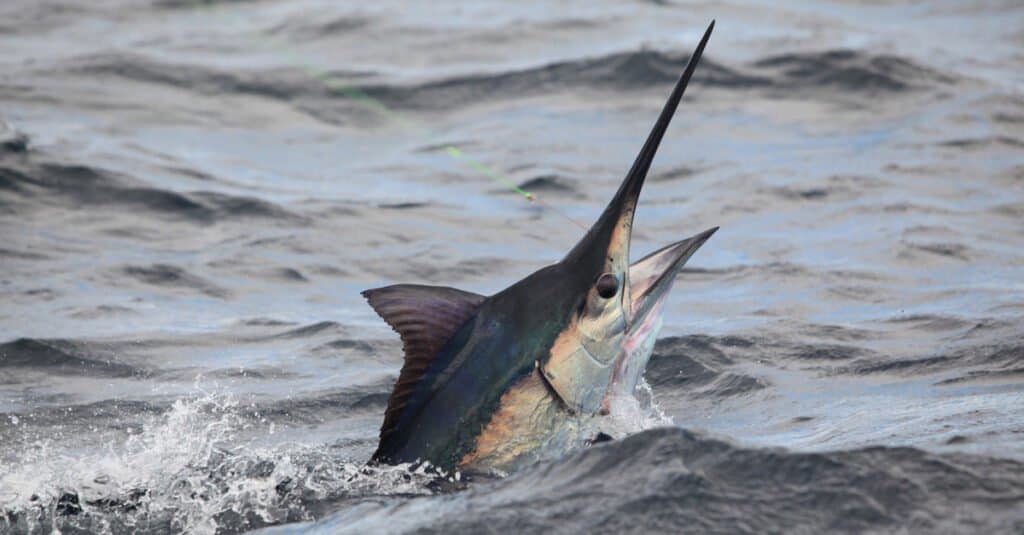
Black marlins are known to swim quickly to attack their prey with a fast slash of their bill.
©Al McGlashan/Shutterstock.com
#3 Swordfish
This marine fish, found predominantly in the Atlantic, Pacific, and Mediterranean, is the only living member of the family Xiphiidae. More distantly, however, it’s actually a part of the same order as the sailfish and marlin, which means there are some similarities between them. For instance, as the name suggests, the swordfish has a massive sword-like bill that’s similar to the black marlin and sailfish. They can also grow up to 15 feet long and weigh around 1,400 pounds.
Reports suggest that the swordfish might be able to achieve a top in excess of 60 miles per hour for short periods of time, but it’s not clear how long it can maintain this speed.
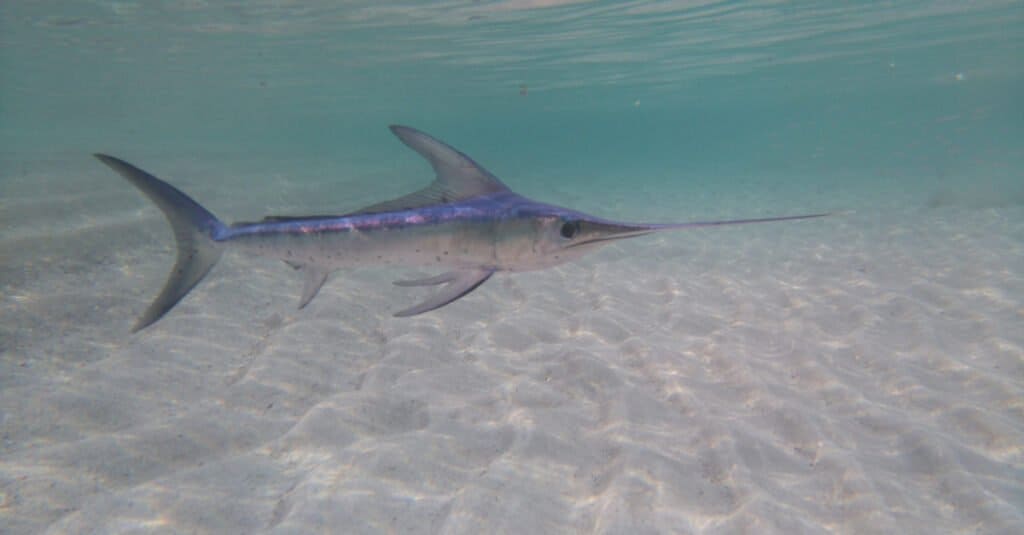
Swordfish rely on their speed and agility to catch their prey.
©SVITO-Time/Shutterstock.com
#4 Wahoo
The wahoo is a slender tropical fish, measuring up to 8 feet long and nearly 200 pounds, with a brilliant blue sheen and a sail-like dorsal fin. It is highly valued by sports fishermen as a top-quality game fish with excellent strength and speed. They are also prized in culinary circles for their delicate taste. Some reports indicate the wahoo can reach top speeds of nearly 50 miles per hour in short bursts, but its normal cruising speed is probably much lower overall.
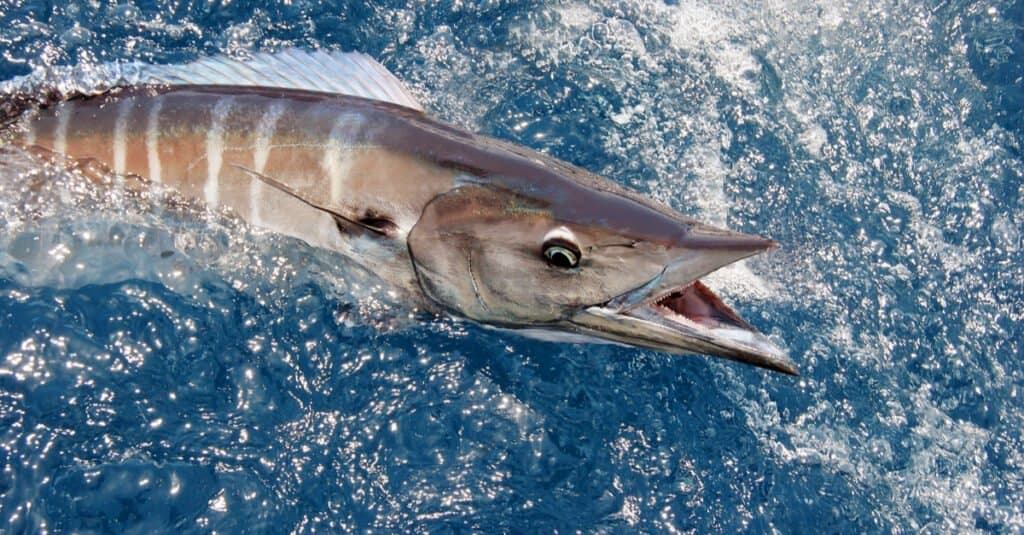
The wahoo’s diet is made up of other fish and squid, which they easily catch thanks to their speed.
©Neophuket/Shutterstock.com
#5 Tuna
The common tuna is beloved as a very popular and tasty dish all over the world, but it’s also remarkable enough in its own right to make a list of the fastest fish. Although they sometimes appear to cruise along slowly, the tuna is an active and agile predator. The sleek and streamlined body enables it to reach high speeds in the pursuit of its prey. The fastest recorded species is the yellowfin tuna at around 46 miles per hour. The Atlantic bluefin tuna, which weighs up to 1,500 pounds and reaches almost 15 feet, can also leap out of the water at speeds of around 43 miles per hour.
Read here to learn more about the tuna.
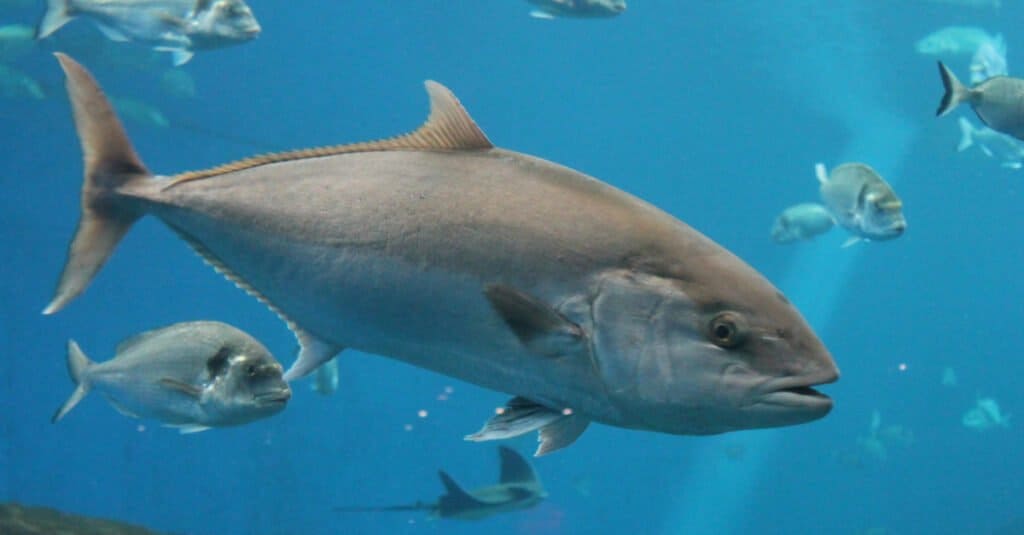
The tuna’s sleek and streamlined torpedo-shaped body makes it one of the fastest fish in the world and a capable predator.
©Lorna Roberts/Shutterstock.com
#6 Bonito
A bonito is a group of eight distinctive fish species, including the Atlantic bonito and Pacific bonito, in the mackerel/tuna family. One of their defining traits is the presence of striped patterns on their sides. Reaching a maximum length of about 40 inches, this very agile fish can leap from the water at speeds of nearly 40 miles per hour.
Read here to learn more about the bonito.
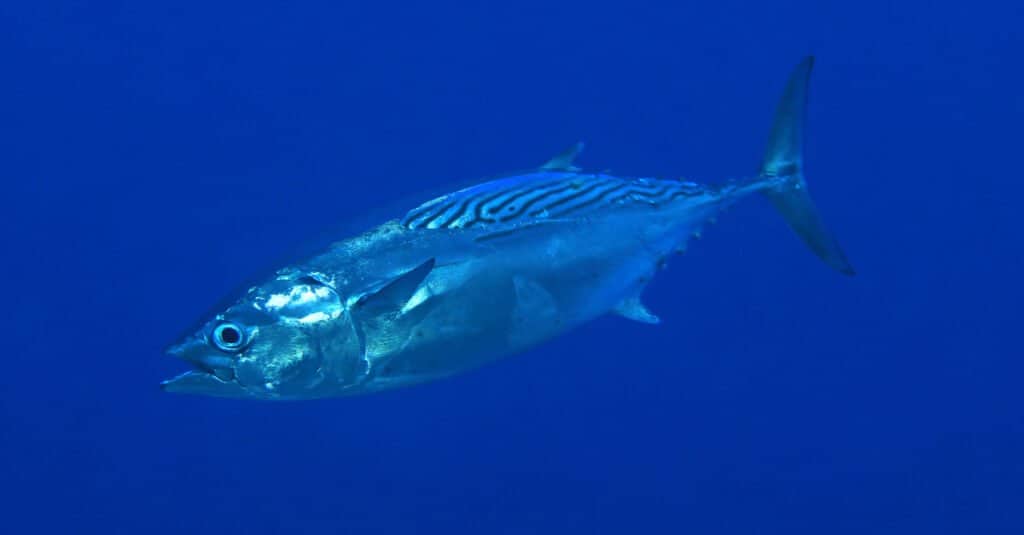
Bonitos can swim up to 40 miles per hour, and they are carnivorous predators that hunt a variety of smaller fish and invertebrates.
©aquapix/Shutterstock.com
#7 Mako Shark
The mako is a genus of big, fearsome sharks, measuring an average of 10 feet and a maximum possible length of around 15 feet. This genus is actually composed of two distinct species: the very common shortfin mako shark and the rarer and more elusive longfin mako. While it’s not the fastest fish in the ocean, the mako is considered to be the fastest type of shark in the world, reaching top speeds of around 40 miles per hour. The secret to the mako’s remarkable speed is the presence of flexible, teeth-like structures called denticles on the sides of the body.
Normally, when water passes over the widest part of the shark’s body, especially right near the gills, it suddenly experiences something called flow separation, in which the water slows down and drops in pressure, causing small eddies and vortices to form. The result of all this water flow is additional drag and turbulence against the body. In order to prevent this from occurring, the denticles will automatically flex up, as if they’re shape-shifting in real-time, so the shark can swim faster and more quietly through the water. This phenomenon is so useful that it’s actually been copied in swimsuits to prevent drag from occurring.
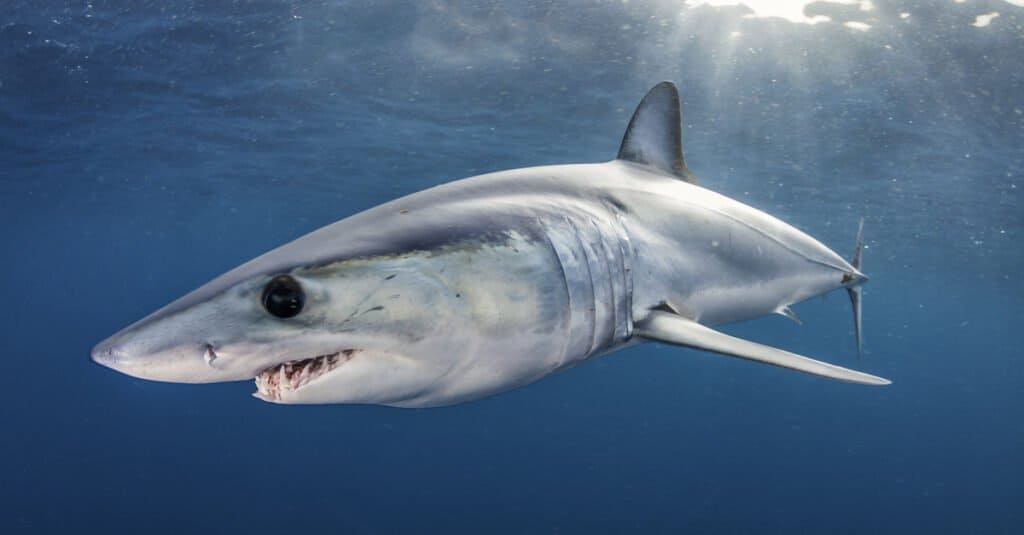
The mako shark is considered dangerous to humans because of its speed — it can attack aggressively and quickly.
©wildestanimal/Shutterstock.com
#8 Blue Shark
Moving stealthily through deep waters, the blue shark is one of the top predators of the world’s oceans. Measuring up to 12 feet long and sometimes weighing more than 400 pounds, they have a long, sleek body and elongated snout with a recognizable bright blue coloration on their upper half. Like the mako shark, they have denticles covering the sides of their body to significantly reduce drag and turbulence in the water. Reports suggest its normal speed is somewhere in the range of 20 to 40 miles per hour.
Read here to learn more about the blue shark.
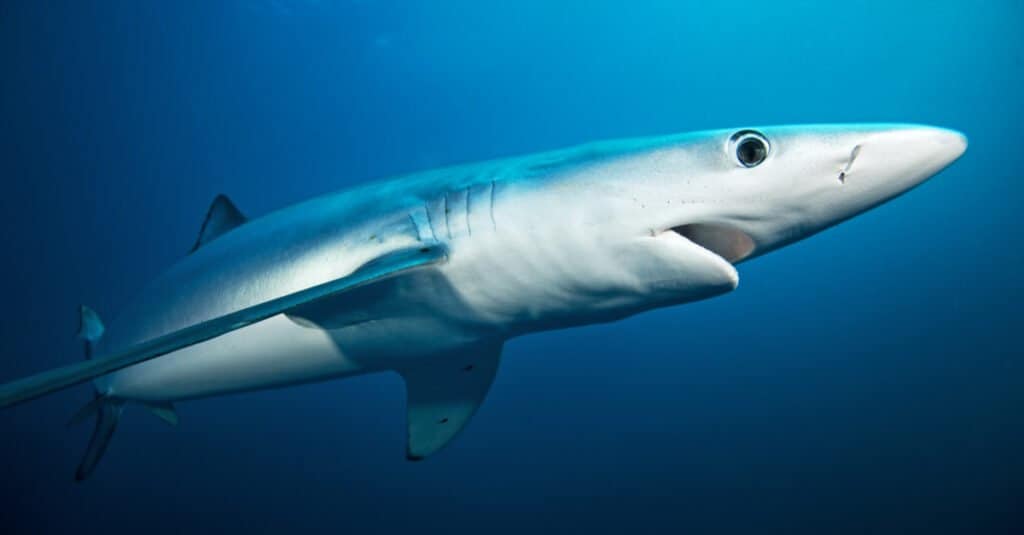
Though not aggressive, blue sharks are sometimes referred to as the “wolves of the sea,” perhaps as they travel at such high speeds.
©Martin Prochazkacz/Shutterstock.com
#9 Bonefish
This medium-sized fish, characterized by the shiny silver body and black stripes, operates on a predictable schedule; gathering in small schools of several fish, they move from tropical inshore waters to shallow mud or sand flats to feed. It is estimated that this species can achieve speeds of up to 40 miles per hour, making it one of the fastest fish in the ocean.
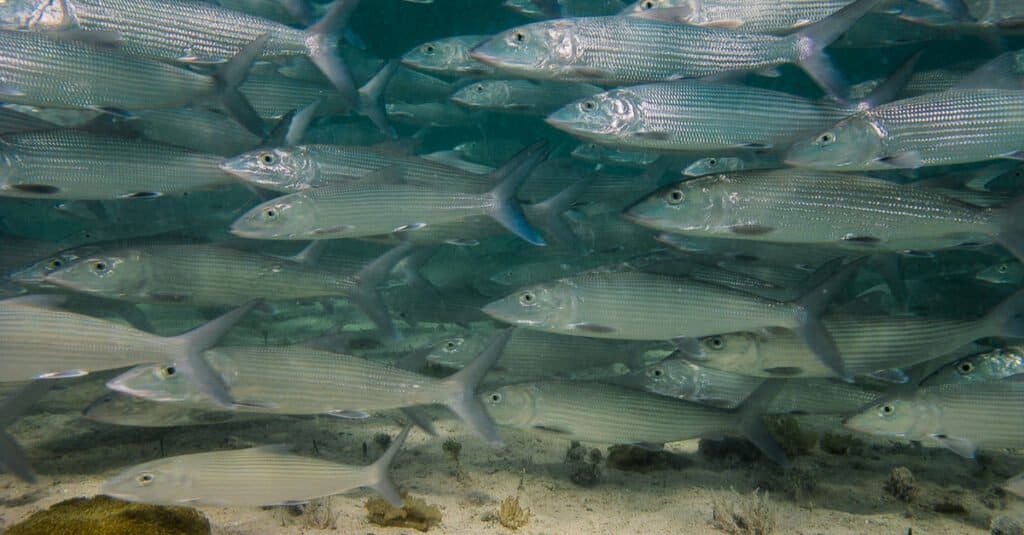
The bonefish can live for up to 20 years. They are relatively small, and their shape assists them in swimming quickly.
©Leonardo Gonzalez/Shutterstock.com
#10 Four-Winged Flying Fish
The flying fish is perhaps one of a kind in the entire animal kingdom. It has the remarkable ability to build up speed, leap out of the water, and glide through the air, sometimes at distances of more than a thousand feet with the right tailwind, to escape its predators. The secret to its success is the wing-like pectoral fins projecting from the side of the body, in addition to all of the skeletal and muscular modifications to accommodate them. But whereas the typical flying fish has only two wing-shaped fins, the four-wing flying fish, as the name suggests, has additional modified pelvic fins for a total of four “wings.” The top speed is thought to be around 35 miles per hour. Despite some misconception, however, they do not flap their wings but instead, glide through the air.
Read here to learn more about the flying fish.

A flying fish’s pectoral fins are modified “wings” that enable them to leap out of the water and glide above the surface.
©Daniel Huebner/Shutterstock.com
Summary of the 10 Fastest Fish in the Ocean
Let’s review the top 10 fastest fish that make their residences in the oceans of the world:
| Rank | Fish | Speed |
|---|---|---|
| 1 | Sailfish | 70 mph |
| 2 | Black Marlin | 30 mph (possibly 82 mph) |
| 3 | Swordfish | 60 mph |
| 4 | Wahoo | 50 mph |
| 5 | Tuna | 46 mph |
| 6 | Bonito | 40 mph |
| 7 | Mako Shark | 40 mph |
| 8 | Blue Shark | 40 mph |
| 9 | Bone Fish | 40 mph |
| 10 | Four-Winged Flying Fish | 35 mph |
Honorable Mention: Other Fast Fish in the Ocean
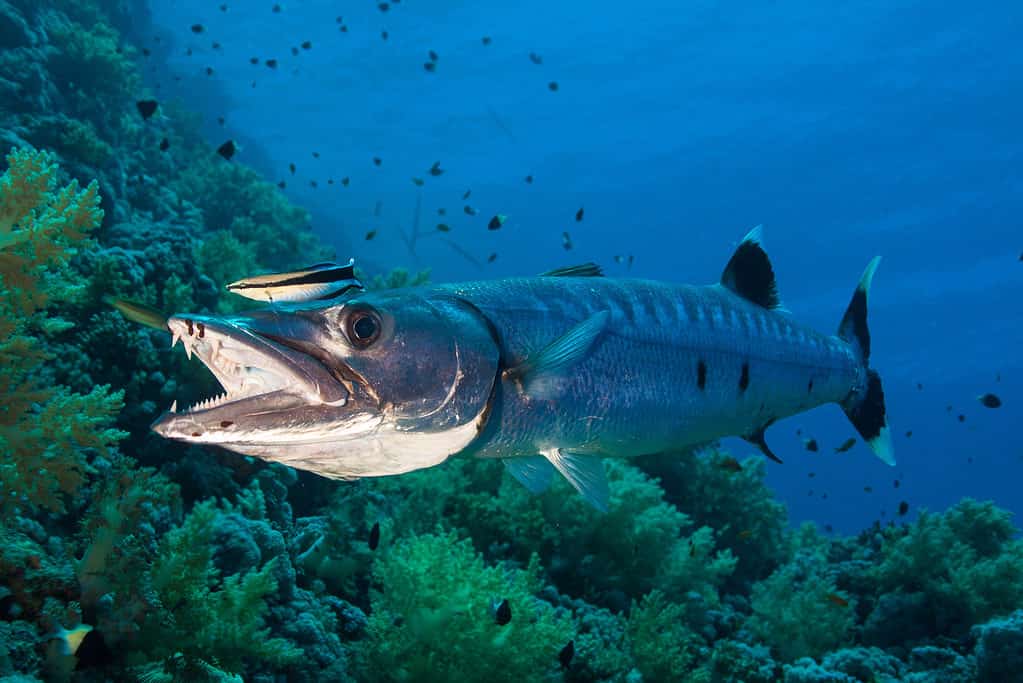
The
barracuda
, a saltwater fish that is found near shore tropical and subtropical seas, is the only genus in the family Sphyraenidae
©Itstvan Kovacs/Shutterstock.com
Oceans cover over 71% of the Earth’s surface and there are about 24,000 living species of fish that reside in them. This gives us an incredible amount of fish to choose from when determining top speeds. They may not all be as fast as the sailfish, but their speeds are still quite impressive and deserve an honorable mention. Some of these fish are:
- Tarpon – there are two species of tarpon in the family Megalopidae – the Atlantic tarpon (Megalops atlanticus) and the Indo-Pacific tarpon (Megalops cyprinoides). Tarpon are considered one of the most loved game fish in the world and are not only strong but fast, capable of swimming up to 35 miles per hour.
- Barracuda (genus Sphyraena) – these marine animals are nicknamed the ‘tiger of the sea’ and can reach speeds of up to 35 miles per hour in short bursts of speed. The great barracuda, which can often reach lengths of five to six feet, is capable of such high speeds due to its pointed snout and long tubular body.
- Great white shark (Carcharodon carcharias) – this species of large mackerel shark can be found in coastal surface waters of all the major oceans. With a swimming speed that is ten times faster than a human swimmer, even Michael Phelps!, this shark is capable of reaching a top speed of 25 miles per hour, although when swimming in short bursts it is able to reach 35 miles per hour.
Thank you for reading! Have some feedback for us? Contact the AZ Animals editorial team.

